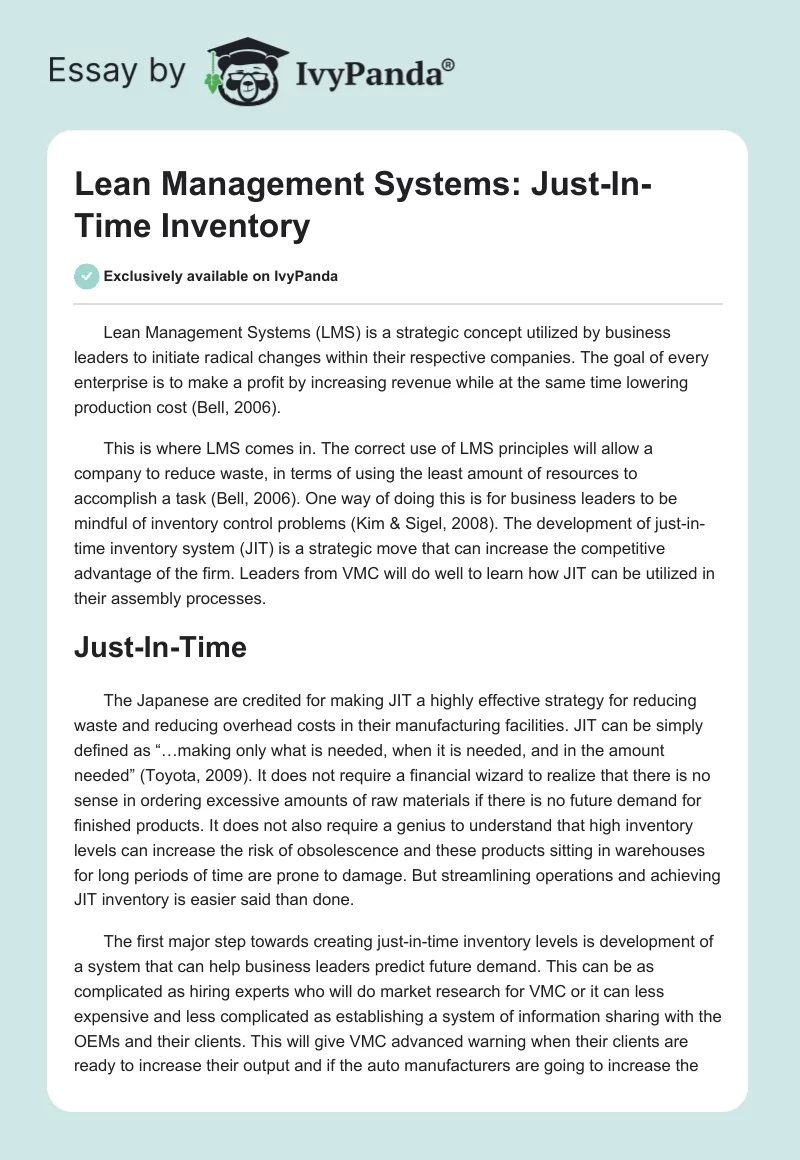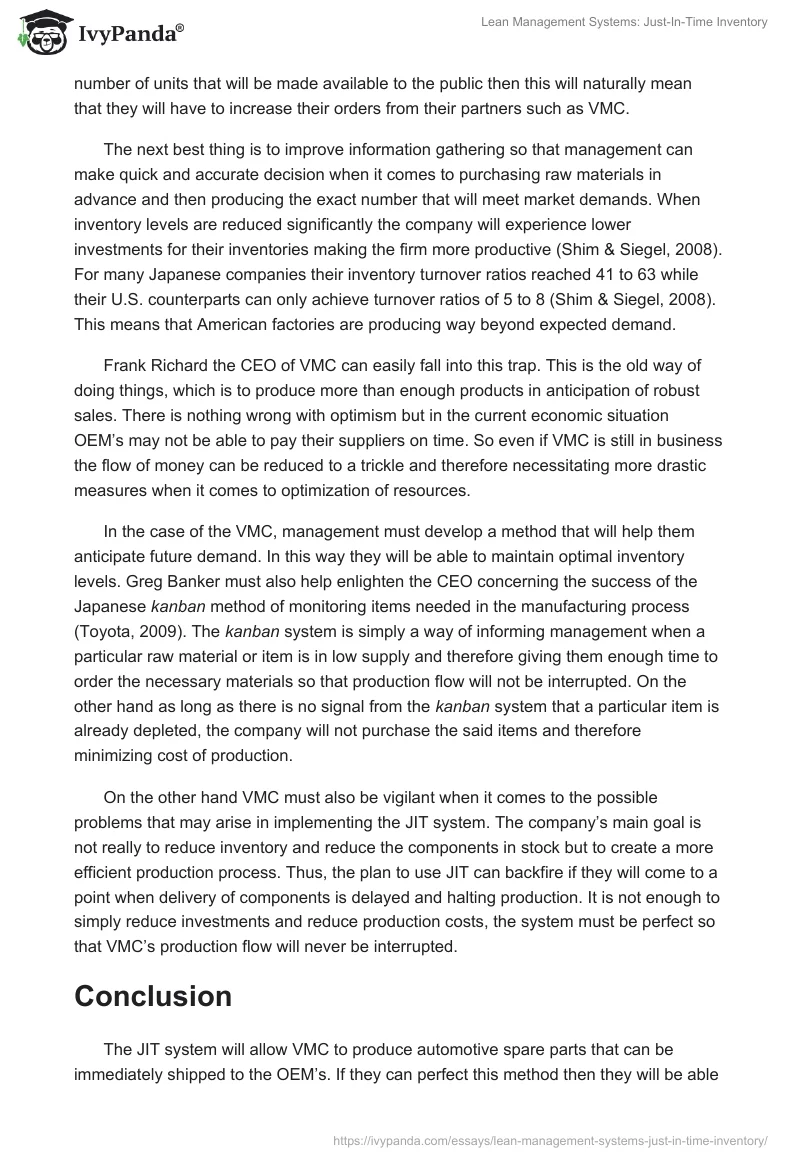Lean Management Systems (LMS) is a strategic concept utilized by business leaders to initiate radical changes within their respective companies. The goal of every enterprise is to make a profit by increasing revenue while at the same time lowering production cost (Bell, 2006).
This is where LMS comes in. The correct use of LMS principles will allow a company to reduce waste, in terms of using the least amount of resources to accomplish a task (Bell, 2006). One way of doing this is for business leaders to be mindful of inventory control problems (Kim & Sigel, 2008). The development of just-in-time inventory system (JIT) is a strategic move that can increase the competitive advantage of the firm. Leaders from VMC will do well to learn how JIT can be utilized in their assembly processes.
Just-In-Time
The Japanese are credited for making JIT a highly effective strategy for reducing waste and reducing overhead costs in their manufacturing facilities. JIT can be simply defined as “…making only what is needed, when it is needed, and in the amount needed” (Toyota, 2009). It does not require a financial wizard to realize that there is no sense in ordering excessive amounts of raw materials if there is no future demand for finished products. It does not also require a genius to understand that high inventory levels can increase the risk of obsolescence and these products sitting in warehouses for long periods of time are prone to damage. But streamlining operations and achieving JIT inventory is easier said than done.
The first major step towards creating just-in-time inventory levels is development of a system that can help business leaders predict future demand. This can be as complicated as hiring experts who will do market research for VMC or it can less expensive and less complicated as establishing a system of information sharing with the OEMs and their clients. This will give VMC advanced warning when their clients are ready to increase their output and if the auto manufacturers are going to increase the number of units that will be made available to the public then this will naturally mean that they will have to increase their orders from their partners such as VMC.
The next best thing is to improve information gathering so that management can make quick and accurate decision when it comes to purchasing raw materials in advance and then producing the exact number that will meet market demands. When inventory levels are reduced significantly the company will experience lower investments for their inventories making the firm more productive (Shim & Siegel, 2008). For many Japanese companies their inventory turnover ratios reached 41 to 63 while their U.S. counterparts can only achieve turnover ratios of 5 to 8 (Shim & Siegel, 2008). This means that American factories are producing way beyond expected demand.
Frank Richard the CEO of VMC can easily fall into this trap. This is the old way of doing things, which is to produce more than enough products in anticipation of robust sales. There is nothing wrong with optimism but in the current economic situation OEM’s may not be able to pay their suppliers on time. So even if VMC is still in business the flow of money can be reduced to a trickle and therefore necessitating more drastic measures when it comes to optimization of resources.
In the case of the VMC, management must develop a method that will help them anticipate future demand. In this way they will be able to maintain optimal inventory levels. Greg Banker must also help enlighten the CEO concerning the success of the Japanese kanban method of monitoring items needed in the manufacturing process (Toyota, 2009). The kanban system is simply a way of informing management when a particular raw material or item is in low supply and therefore giving them enough time to order the necessary materials so that production flow will not be interrupted. On the other hand as long as there is no signal from the kanban system that a particular item is already depleted, the company will not purchase the said items and therefore minimizing cost of production.
On the other hand VMC must also be vigilant when it comes to the possible problems that may arise in implementing the JIT system. The company’s main goal is not really to reduce inventory and reduce the components in stock but to create a more efficient production process. Thus, the plan to use JIT can backfire if they will come to a point when delivery of components is delayed and halting production. It is not enough to simply reduce investments and reduce production costs, the system must be perfect so that VMC’s production flow will never be interrupted.
Conclusion
The JIT system will allow VMC to produce automotive spare parts that can be immediately shipped to the OEM’s. If they can perfect this method then they will be able to predict market demand for their products and therefore plan ahead when it comes to the purchase of components needed to sustain production flow. By having optimal inventory levels VMC will be able to lower their investments when it comes to floor space for inventories and production. They can reduce the risk of obsolescence in their inventories and they can also reduce scrap and rework (Shim & Siegel, 2008). In other words VMC will dramatically improve their productivity, saving money and increasing their profit.
References
Bell, S. (2006). Lean Enterprise Systems. New Jersey: John Wiley & Sons, Inc.
Shim, J., J. Siegel. (2008). Financial Management. New York: Barron’s Educational.
Toyota. (2009). Toyota Production System. Web.


